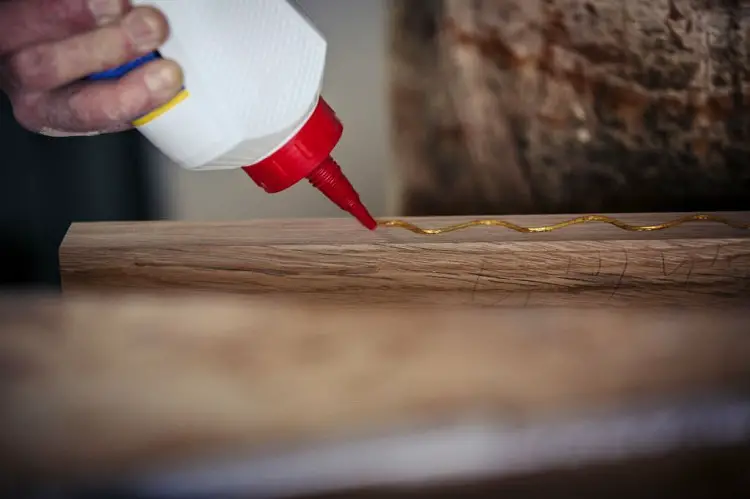As someone who cares about household materials, it is okay to ask the question “Does super glue work on wood”?
Super glue, formally known as cyanoacrylate adhesive, is a widely utilized and versatile adhesive known for its ability to form rapid and sturdy bonds between various materials including wood.
One of the common inquiries regarding super glue is its effectiveness on wood.
In this article, we will look into the properties of super glue and its interaction with wood, outlining the steps to achieve a successful bond and considering both the advantages and considerations associated with using super glue on wood.
Understanding Super Glue
Super glue is an adhesive that belongs to the cyanoacrylate family. It is renowned for its quick adhesion and robust bonding properties.
The glue works by creating a chemical bond upon contact with moisture, which is present on most surfaces, including wood.
The moisture initiates a polymerization process, forming strong bonds within seconds of contact.
Does Super Glue Work on Wood?
The answer is Yes. Super glue does work on wood. This makes it a convenient, mess-free, and quick option if you have wood projects.
But you must always bear in mind that despite the fact that super glue does work on wood, it works best on small projects, such as small wooden toys or models. The glue is also ideal for filling gaps and cracks.
How Super Glue Bonds with Wood
Wood, despite being a porous material, can actually be effectively bonded with super glue. The reason for this is due to the moisture that is contained within the wood fibers.
When super glue is applied to a wood surface, it reacts with the moisture present, which facilitates a chemical reaction that creates robust and long-lasting bonds.
In fact, the porous nature of wood is actually an advantage when it comes to bonding with super glue.
The adhesive is able to penetrate and adhere to the wood fibers, resulting in a strong and durable bond that can withstand various stresses and strains.
As a result, super glue is a great option for woodworking and other DIY projects that involve bonding wood materials together.
Steps for Using Super Glue on Wood

1. Prepare the Surface
Preparation is crucial for a successful bond. Begin by ensuring that the wood surface is clean, dry, and free of any dirt, debris, or oils. If needed, use sandpaper to smooth the surface and enhance adhesion.
2. Apply Super Glue
Apply a small amount of super glue to one of the surfaces intended for bonding. It is advisable to use an applicator or the nozzle of the glue bottle for precise and controlled application.
3. Join the Surfaces
Press the two wood surfaces firmly together, ensuring an even distribution of the adhesive. Maintaining consistent pressure for a few seconds allows the glue to set effectively.
4. Cure Time
Super glue typically sets quickly, often within a few seconds to a minute. However, to achieve maximum strength and durability, it’s best to allow the bond to cure for several hours.
5. Optional: Reinforce the Bond
Depending on the intended application and load-bearing requirements, you may opt to reinforce the bond by using additional fasteners or clamps while the glue cures.
Advantages and Considerations
Advantages
- Quick Bonding: Super glue offers rapid bonding, allowing for efficient project completion, especially for tasks that require immediate adhesion.
- Strong Bond: When used correctly, super glue creates a powerful and enduring bond on wood, contributing to the structural integrity of the project.
- Versatility: Super glue is versatile and can bond different types of wood and wood products effectively.
Considerations
- Porosity: The porosity of the wood may impact the bond strength. Highly porous wood might require more glue or additional bonding techniques to achieve a strong bond.
- Moisture Content: The moisture content in the wood can affect the bond quality. Dry wood may need slightly more glue or added moisture to achieve an optimal bond.
- Stability and Flexibility: Super glue can become brittle over time, making it less suitable for applications that require flexibility or resistance to impact.
Precautions To Take While Using Super Glue
In as much as you are using super glue or you are an avid lover of using super glue in your home for certain things, you should always have at the back of your mind that Super glue is not food safe, though.
The FDA kicks against using it on food packaging or any other items that come in contact with food.
It is not advisable to keep using it on wooden dinnerware and utensils, as well as chopping boards and other kitchen items.
Objects glued by this adhesive are also a fire hazard, so keep them away from your oven or microwave to avoid jeopardizing your safety and those of your family by not allowing carelessness to cost you intensively
While accidentally applying super glue on the skin is not serious, ingesting it is a different matter, as even small amounts could lead to serious digestive problems.
The toxicity remains unchanged even after the glue cures. Super glue is pretty easy to use on its own, but if you want to get the best results, our team suggests keeping the following tips in mind
When Not To Use Super Glue On Wood
While super glue can be an effective adhesive for bonding wood in many situations, there are specific scenarios where it may not be the best choice.
It’s important to consider these circumstances to ensure a successful and durable bond when working with wood.
1. Large Gaps or Uneven Surfaces
Super glue works best when surfaces fit closely together.
If you have significant gaps or uneven surfaces that need to be joined, using a wood filler or a different type of adhesive that can bridge larger gaps would be more appropriate.
2. High-Stress Joints
In applications where the joint will experience substantial stress or bear significant loads, super glue alone may not provide the required strength.
Consider using mechanical fasteners (e.g., screws, dowels, nails) in addition to super glue for added structural integrity.
3. Applications Requiring Flexibility
Super glue tends to become brittle over time and may not maintain its integrity in applications that require flexibility, such as joints that will move or bend.
In such cases, flexible adhesives like epoxy or polyurethane-based adhesives would be more suitable.
4. Exposure to Extreme Temperatures
Super glue can be sensitive to extreme temperature variations.
If your woodworking project will be exposed to high or low temperatures, consider using an adhesive specifically designed to withstand these conditions for a longer-lasting bond.
5. Outdoor or Wet Environments
Super glue is not ideal for outdoor projects or applications exposed to moisture, as it can weaken and degrade in wet conditions.
For outdoor woodworking projects, opt for weather-resistant wood glue or epoxy designed for outdoor use.
6. Food Contact Surfaces
Super glue is not food-safe, so it should not be used on surfaces that will come into direct contact with food or beverages.
For woodworking projects involving items like cutting boards or kitchen utensils, use food-safe adhesives that are specifically designed for such applications.
Wood Glue Vs Super Glue: Which One is Better To Use?
Different types of glue are suitable for different purposes, and there is no one-size-fits-all solution. Wood glue and superglue each have their advantages.
Krazy Glue and Gorilla Glue are waterproof once they have cured, while certain other wood glues can be used for both indoor and outdoor projects.
The label of the bottle or product should indicate whether it is intended for exterior or interior use.
One major difference between wood glue and superglue is that wood glue is not clear, while superglue is.
Additionally, wood glue is not designed for use on plastics or other materials, so the choice of which type of glue to use depends on the specific project requirements.
Another difference between these two types of glue is their consistency. Wood glue is thicker and more viscous, usually coming in a bottle that needs to be inverted to dispense the glue. On the other hand, superglue is more like a runny liquid.
When it comes to drying, superglue dries clear, while some types of wood glue may dry clear or match the color of the wood.
Wood glue can also be sanded once it has dried, unlike superglue. It only takes about thirty minutes for wood glue to be unclamped, but it needs a full 24 hours to cure completely.
Read Also:
- How To Block WiFi Signals in a Room
- How to Clean Grout Without Scrubbing
- 10 Creative Ways to Stop Your Couch From Sliding
- Can I Use Pine Sol on Engineered Wood Floors? Explained
Frequently Asked Questions
How to glue wood to glass material
When attaching something to glass, consider how any leftover glue might affect the appearance of your project.
If looks are important, it’s best to use a clear adhesive. To bond glass and wood, such as in a window frame, use a water-resistant silicon adhesive.
If you don’t need such a strong bond, a hot glue gun is a safer option. Remember to clean both surfaces before gluing.
How to glue wood to metal material
When joining wood to metal, it’s best to use adhesives that expand while curing, such as Gorilla Glue.
These adhesives are strong and flexible, allowing them to withstand the shrinking and expanding of the two materials due to changes in moisture and temperature.
Always read and follow the instructions and warnings on the product label when using any type of glue. Remember that wood and metal behave differently and require special consideration during the gluing process.
Are there other glues stronger than super glue?
Epoxy is widely regarded as the strongest adhesive among all reactive adhesives.
Although it takes only one hour to cure, it takes around twenty-four hours to reach its maximum strength potential.
Other examples of reactive adhesives include polyurethane and super glue. Some adhesives cure by evaporating the solvents, creating a bond between materials.
Conclusion
I am sure your question “Does super glue work on wood”? has been answered, and you are well-informed now about super glue.
Super glue is indeed a suitable adhesive for bonding wood, providing a swift and robust bond when used correctly.
Proper surface preparation, precise glue application, and adequate curing time are essential steps in achieving an effective bond.
Understanding the characteristics of both the wood and the super glue will aid in achieving optimal results in a variety of woodworking projects.
The versatility and bonding capabilities of super glue make it a valuable tool in the woodworking toolbox, ensuring the success of various bonding applications involving wood.

